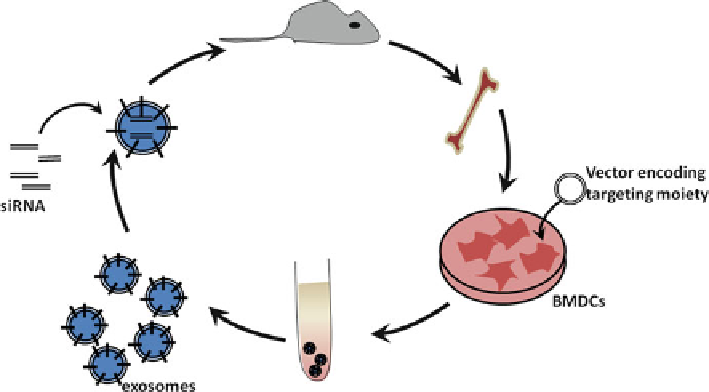Biology Reference
In-Depth Information
Fig. 9.4
Bone marrow dendritic cell-derived exosomes as siRNA delivery vehicles. BMDCs are
generated from bone marrow cultures by differentiation with GM-CSF. BMDCs are transfected
with a vector for expression of the targeting moiety (e.g., RVG) in fusion with an exosomal mem-
brane protein (e.g., Lamp2b). Exosomes are harvested from supernatants by ultracentrifugation
and loaded with siRNA by electroporation. Targeted and loaded exosomes are then injected into
mice intravenously
The therapeutic value of this approach was demonstrated with exosome-complexed
curcumin in LPS-induced inflammation and experimental allergic encephalomyeli-
tis (EAE) and with an exosome-complexed stat3-inhibitor in a glioblastoma tumor
model. Authors demonstrated that exosomes administered intranasally are potential
delivery vehicles for small anti-inflammatory molecules, by increasing their bio-
logical stability and enabling them to bypass the BBB. This study represents further
proof of concept for membrane vesicles as drug delivery vehicles with fast and
selective homing to the brain and highlights the wider potential of membrane vesi-
cles and exosomes in particular beyond oligonucleotide delivery, to include a poten-
tially wider range of therapeutic cargoes.
9.4.3
Advantages of Exosomes over Existing RNAi
Delivery Vehicles
These studies have also highlighted the advantages of using exosomes over viral
vectors and liposomal formulations for RNAi delivery, particularly in vivo. In addi-
tion to being naturally derived vesicles, comprised of endogenously
expressed proteins, RNAs, and lipids, exosomes appear capable of targeted deliv-
ery of exogenous RNAi cargoes to the site of silencing in the recipient cell, a feature

Search WWH ::

Custom Search